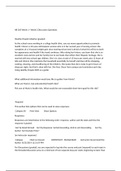Study guide
Molecular principles of development: extra study material, key concepts
- Instelling
- Radboud Universiteit Nijmegen (RU)
This document can be used as extra study material and consists of all the main topic you should know for the exam. These concepts refer to the summary of molecular principles of development which is also available.
[Meer zien]














